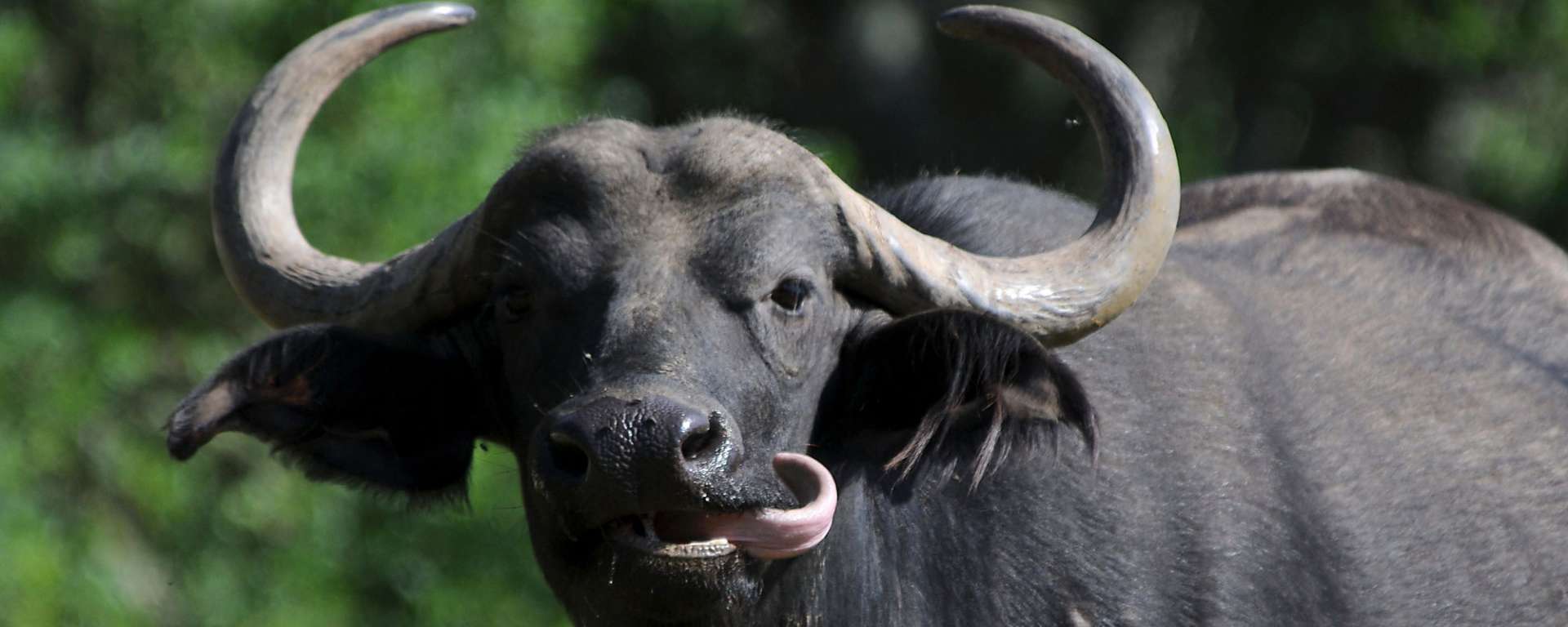Safari Spotlight: the Cape Buffalo
Posted in: Safari Spotlight
Tags: cape buffalo
In this month’s Spotlight, we cast our attention on the Cape Buffalo. While not as well known as the giraffe or the rhinoceros, the cape buffalo is nonetheless one of the crown jewels of our collection. These massive ruminants, fearsome in both appearance and temperament, are not only some of the largest animals we have but also make up one of the largest herds at Safari West.
The cape buffalo has the dubious honor of being part of the famous “Big 5”. Big 5 is a term originating in the world of big-game hunting and includes lions, leopards, elephants and rhinos alongside the cape buffalo. The Big 5 are considered to be the five animals most difficult and challenging to hunt (namely because they are the animals most likely to run at you rather than away if you are foolish enough to shoot at them). Happily, in recent decades, the term Big 5 has been appropriated by the tourism industry and now more accurately describes the five species people out there on safari want to see.
We recently had a brand new baby appear in our herd. This latest arrival brings the herd total to 27 animals. With the adults in our herd ranging in size from 1500-2000 pounds apiece, 27 buffalo clustered around the feed trough is quite a sight to behold. The littlest buffalo is quite tiny in comparison to her parents and herd-mates but her stout little legs and thick neck already hint at the behemoth she’ll become.
A full-grown cape buffalo is an imposing animal, massive and heavily built. They resemble cows in the general body layout, (four legs, horns, a tail) but that’s just about it as far as any resemblance goes. There is a density to the cape buffalo that’s startling and obvious on first look. They are heavily muscled and sturdy. Their hair is short and dark, typically darkening with age until they are a uniform black. Their horns (which incidentally are also black) are heavy and sharp on both genders although on males they tend to curve up and out into vicious sickle points and stretch out from a structure called a “boss”. The boss is a thickening of the base of the horn that forms a helmet-like structure across the top of the animals head. It almost makes them look a bit like they’re sporting the old colonial-era powdered wigs until you realize the wigs end in nightmarish points.
Our herd is quite large at 27 animals but that’s nothing compared to the herds that can be found in the wild, ranging anywhere from 50 to 500 animals. As big as cape buffalo are, and congregating in such impressive numbers, you may imagine they are basically immune to predation and in point of fact, they very nearly are. According to the University of Michigan Museum of Zoology, disease is the most common cause of death for this species. That said, “nearly” is not “completely” and after disease, predation by lions is the second highest cause of buffalo mortality.
Lions, thanks to their large size (300-400 pounds on average) and habit of hunting in large groups, are just about the only habitual predator of cape buffalo. When confronted by lions, the buffalo herd’s primary response is flight. Running is less risky than fighting. That said, if running doesn’t work, this species is fully capable of defending itself. If forced into a fight, the herd will shuffle ranks so as to keep the vulnerable members (youngsters, pregnant females, older animals, etc) toward the center and push the typically larger (and biologically more expendable) males to the periphery. This presents a formidable united front made up of very heavily built animals carrying highly developed weaponry. These very capable defenders are also capable of going on the offense from time to time. It is not uncommon for cape buffalo to actually initiate aggression with lions and other predators; chasing (and sometimes killing) them on sight rather than waiting for them to initiate an attack on the herd. This is called reciprocal aggression and is unusual in a prey species.
These impressive animals have a softer side as well. There are numerous recorded instances of lost or orphaned calves being cared for or even “adopted” by older females. These nanny buffalo will sometimes take over the care of multiple calves. Equally as surprising are cases that don’t involve the young. There have been recorded instances of cape buffalo assisting blind or even three-legged members of the herd.
Imposing and unnerving though they may be, cape buffalo are also beautiful animals, fascinating for both their physical prowess and their social complexity. Simultaneously fierce and nurturing, they are truly a marvel to behold and you can see them every day here at Safari West. Dominating the hundred-acre enclosure they share with our wildebeest and ostriches, the cape buffalo is a highlight of every classic safari tour.


